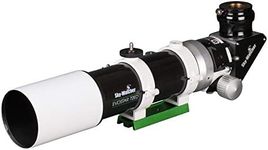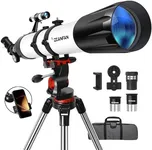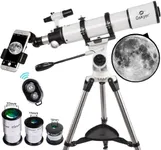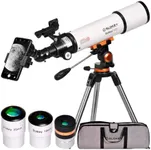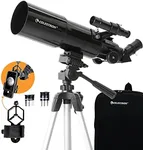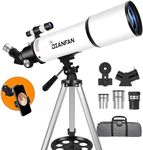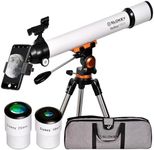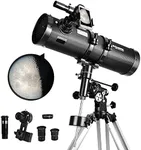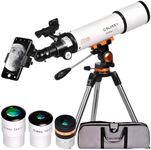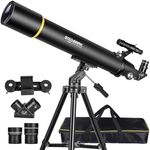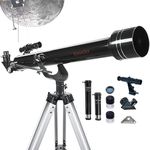Buying Guide for the Best Telescopes For Adults
Choosing a telescope as an adult can be an exciting journey into astronomy, whether you're a beginner or looking to upgrade your stargazing experience. The right telescope will depend on what you want to observe, how portable you need it to be, and how much effort you're willing to put into setup and learning. Understanding the main features and how they affect your viewing experience is key to making a satisfying choice.ApertureAperture refers to the diameter of the telescope's main lens or mirror, and it's one of the most important specs because it determines how much light the telescope can gather. More light means you can see fainter objects and more detail. Aperture sizes are usually measured in millimeters or inches. Small apertures (under 80mm) are lightweight and good for casual viewing of the moon and bright planets. Medium apertures (80mm to 130mm) offer a balance between portability and the ability to see more celestial objects, including some deep-sky objects. Large apertures (over 130mm) are best for serious observation of faint galaxies and nebulae but are heavier and less portable. Choose an aperture based on what you want to observe and how much you're willing to carry and set up.
Focal LengthFocal length is the distance from the telescope's lens or mirror to the point where it forms an image. This affects the magnification and field of view. Short focal lengths (under 700mm) give a wider view, which is great for scanning the sky and viewing large objects like star clusters. Long focal lengths (over 1000mm) provide higher magnification, making them better for detailed views of planets and the moon. If you want to see a variety of objects, a medium focal length offers versatility. Your choice should depend on whether you prefer wide, sweeping views or close-up details.
Mount TypeThe mount is what holds the telescope steady and allows you to aim it. There are two main types: alt-azimuth and equatorial. Alt-azimuth mounts move up/down and left/right, making them simple and intuitive for beginners. Equatorial mounts are designed to follow the rotation of the sky, which is helpful for tracking objects as the Earth turns, especially useful for astronomy enthusiasts and those interested in astrophotography. If you want easy setup and use, go for an alt-azimuth mount. If you plan to do more serious observing or photography, consider an equatorial mount.
PortabilityPortability refers to how easy it is to move and set up your telescope. Smaller, lighter telescopes are easier to transport and set up, making them ideal if you plan to travel to dark-sky locations or have limited storage space. Larger telescopes can offer better views but may require more effort to move and assemble. Think about where you'll use your telescope most often and how much weight and bulk you're comfortable handling.
Eyepieces and AccessoriesEyepieces determine the magnification and quality of the view through your telescope. Most telescopes come with one or two eyepieces, but you can buy more to expand your viewing options. Lower magnification eyepieces give a wider view, while higher magnification ones let you see more detail. Other accessories, like finderscopes and filters, can make observing easier and more enjoyable. Consider what comes with the telescope and whether you'll want to add more accessories as your interest grows.
Ease of UseEase of use covers how simple it is to set up, align, and operate the telescope. Some telescopes are designed for quick setup and intuitive use, while others require more time to learn and adjust. If you're new to astronomy, look for models that are known for being user-friendly. If you enjoy tinkering and learning new skills, you might be comfortable with a more complex setup.

